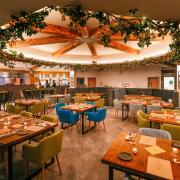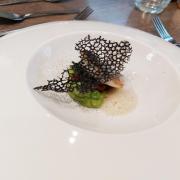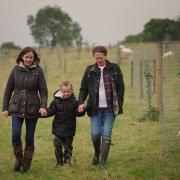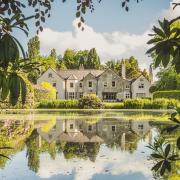In the first of his watering hole walks, John Lenehan traces the River Darwen and passes one of Lancashire most dramatic castles

This walk was published in May 2015, so the details of the route may no longer be accurate, we do advise these articles should only be used as a guideline for any potential route you take and you should double check an up to date map before you set off.
A good place to start and finish any walk is at a pub or café. Good food and drink are most welcome after tramping a few miles and on this walk the Royal Oak at Riley Green offers excellence in both categories.
The route is quite simple if the waypoints are followed and it's good underfoot in the majority. It can be a little muddy along the side of the River Darwen and crossing some of the fields so walking boots should be the preferred footwear.
There are also quite a few stiles to negotiate. For ornithologists it is worth taking the binoculars as many species of birds can be seen and down by the river you may catch sight of the elusive kingfisher. Historically, the walk is interesting and I will refer to this on the route.

1. Leave the Royal Oak car park heading towards Preston then take the first left and follow the A675 to point 2.
2. At the canal bridge leave the road and go left to join the towpath keeping the canal to your right. The Marina and pub across is known as the Boatyard and canal cruises depart from there. Around 200 years ago a Mr Crook had a coal yard here with his own barge. When he was charged £100 for it to be repaired he decided he could build his own boat for less. He did and a boatyard business was born and lasted until the 1960s. Keep on the towpath passing under two bridges to reach point 3.

3. Reach the metal bridge but do not go under or over it. A path joins the towpath from the left so follow this downhill past the now demolished Sappi Paper Mill on the right. At the bottom bear right towards a brook then left and up to point 4. Sappi Paper Mill used to be called the Star Paper Mill and to the left of the brook is the site of the Sun Paper Mill and also in the area once stoodthe Moon and the Eclipse Paper Mills.
4. Go through the stile in the metal railings and turn left up the A674 past a row of terraced houses and onto point 5. Look right as you leave the stile and over the bridge you will notice the ruined gatehouse of Feniscowles Hall, once a magnificent mansion belonging to a branch the Fielding family of Blackburn. They left because the River Darwen became so polluted that they could not stand the smell.
5. Turn right up a farm track towards Hillock Farm and just before the farm there is a stile on the left at point 6.
6. Go through the stile and keeping the farm on the right cross diagonally right to a step stile in the fence. Go over the stile and keeping the fence on your left follow this to a gate stile and once through this head diagonally across to point 7.
7. There is a gate stile to enter the woods. Go through this and turn sharp left then follow the path down hill until it reaches a stile into open fields with the River Darwen on the right. Keeping the river on the right cross the field and reach a stile that enters another wood. Keep on the path and pass a large weir then under the huge railway viaduct to point 8. The weir provided water to power two textile mills in Hoghton Bottoms and the course of the millrace is on the left of the path past the weir. One of the mills is still standing on the right of point 8 but has been converted to a house. The viaduct is 116ft high and the wood for the scaffolding used in building it came from the boatyard of Mr Crook.
8. There is a row of old Weavers Cottages but do not take the road past the front of these, take the rough track that goes to the left behind them and climb uphill past a ruined building and onto point 9.
9. A gate stile leads onto to the railway line, take care crossing the line to the opposite gate stile as this is a very fast part of the line for trains. Once over the line enter the woods and climb up through the old ruin of a bridge to reach the perimeter wall of Hoghton Tower then turn right and keeping the wall on the left go uphill to a step stile in a wall. Cross this and with the perimeter wall still on the left follow this to a step stile then onto another step stile and into a track with houses to the left and onto point 10.
10. Cross the long drive of Hoghton Tower and through a gate stile opposite. Hoghton Tower is open to visitors and is a popular wedding venue. King James I knighted the loin of beef he ate during a three day visit to the tower in 1671 hence the name Sirloin. It is also reputed that in honour of his visit a red carpet was laid all the way down the drive for his arrival. Sir Richard de Hoghton was almost bankrupted by the cost. Once through the stile follow the track on the left uphill and cross a step stile by a gate then follow the track into open fields. The path can be a little indistinct here but straight ahead there is an old lightning tree so aim for that and cross the step stile into the next field. Carry on straight downhill to a step stile next to Green Lane Farm and onto the track that leads to the Royal Oak and a well earned meal.
Factfile
Distance: 4.6 Miles
Time to allow: 2-2 1/2 hours
Watering hole: The Royal Oak, Blackburn Old Road, Riley Green, PR5 0SL, is open seven days a week serving Thwaites beer and much of the food is locally sourced. The menu included pub classics such as steak and kidney pudding and fish and chips. The Boatyard Inn at Bolton Road, Riley Green, PR5 0SP, also serves Thwaites beer, food and if you are tired after the walk, a bed for the night.
Map: OS Explorer 287 West Pennine Moors.



























